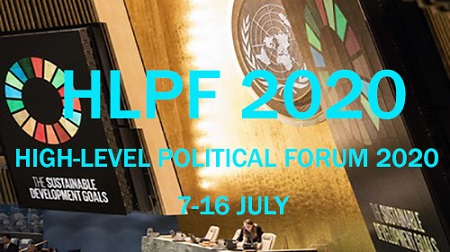HIC Concerns about Sustainable Development

In advance of the UN’s High-level Political Forum (HLPF), 7–16 July 2020, to review Sustainable Development Goal progress, the UN Department of Economic and Social Affairs (UNDESA) solicited 1-page statements from the Major Groups and Other Stakeholders (MGOS) in the upcoming Forum. For its part, Habitat International Coalition summarized its own perspective on the HLPF process as follows:
In addition to the many fault lines laid open amid the COVID-19 pandemic, our worldwide membership is deeply concerned as UN Member States sleepwalk through the potentially irreversible distortion of the global system coinciding with their pursuit of the 2030 Agenda. We were encouraged by the promises of the longer-term positioning of the UN Development System (UNDS), resting firmly on all three pillars of the UN Charter at once. The ‘Transforming our world’ vision and consensus resolution still promise to uphold human rights and humanitarian law, even when such preambulatory references are not found consistently in the Sustainable Development Goals (SDGs), their Targets or Indicators. Corresponding policies, operational directives and other norms call for greater coordination at ‘managing resources and efforts at a higher vantage point,’ ‘ensuring accountability,’ ‘pooling expertise and assets across the Organisation,’ ‘anticipating risks’ and working to ‘resolve the data gap, while assets are scattered across the System.’ At the same time, ‘prevention…needs to be an integral part of the activities of the United Nations development system…violations of human rights are often our best early warning signs of trouble.’
While such wisdom is heartening when found in policy instruments, none of these promises can be realised without a robust and effective Human Rights Treaty System. However, the global trend shows many states and their governments in galloping retreat from their obligations under treaty, general principles and peremptory norms. The United Nations System is also undergoing erosion from within by favoring ‘voluntary’ inter-governmental forums to parley political ‘commitments,’ while effectively supplanting states’ prior ‘obligations’: The very tools of statecraft articulated more thoroughly in the Human Rights Treaties and the authoritative interpretations of their respective Treaty Bodies.
Preciously few VNRs, their presentations or diplomatic responses reflect a conscience about the common individual, collective, domestic and extraterritorial obligations of States. Simultaneously, the UN has been defunding the Treaty System, which should be a central stalwart of international cooperation and world order. Meanwhile also, the SDG Targets and Indicators still fall short of the criteria—including the relevant data—in the Treaty System that are mandatory in states’ periodic reporting on their treaty performance. This delinking of States’ permanent and binding obligations from sustainable development negates the UNDS vision of ‘providing normative support to countries to establish, implement, monitor and report on norms, normative standards and agreements, including on international human rights commitments’ [read: obligations]. Without operationalizing this approach, the HLPF has consolidated an alternative discourse that maintains mostly static structural and (putative) outcome indicators without the indispensable process indicators that guide and demonstrate action, while we are supposed to be ‘transforming our world’ into ‘the future we want.’
Hence, this year’s consideration of VNRs ‘through the human rights lens’ is especially appropriate, if not long overdue. States implementing their human rights obligations is essential to accelerating action; however, these transformative pathways are certainly not new. Protecting and advancing human wellbeing and ending poverty, especially in this time of crisis, call for conscious prevention of, and remedy for human rights abuses not reflected in the Goals, Target or Indicators. Meanwhile, the humanitarian and erga omnes obligations cited in A/RES/70/1 [AR], para. 35 find no corresponding Goal, Target or Indicator whatsoever, not even in SDG 17. The consequences of that omission remain dire.
Notable to HIC is Goal 11’s neglect of the human right to adequate housing [AR], its codified elements, and the corresponding obligations of States [AR]. Meanwhile, amid this pandemic, various spheres of government and felonious agents are forcibly evicting our most impoverished and vulnerable inhabitants with impunity, often despite both binding obligations to refrain from, protect against and remedy such gross violations. All States Parties to ICESCR are required to report on domestic forced evictions and their impacts every five years, no whisper of prevention, but neither reporting criteria or remedy are found in the UNSDS side of the System. This pattern of abuse notably spans many countries [AR], especially during the pandemic, and promises to plunge our most disadvantaged into even greater peril. Meanwhile, this sure retrogression of development objectives continuously escapes the methodological purview at HLPF.
|